2 pdi register function acknowledge by write, Pdi register function acknowledge by write – BECKHOFF EtherCAT Technology Section I User Manual
Page 112

Process Data Interface (PDI)
I-92
Slave Controller
– Technology
16.2 PDI register function acknowledge by write
Some ESC functions are triggered by writing or reading individual byte addresses, e.g., SyncManager
buffer change or AL event request acknowledge. With an increasing data bus width of the
µControllers, this can lead to restrictions or even problems.
Since most µControllers are using byte enable signals for write accesses, there is no restriction for
functions which are triggered by writes. But many µControllers are not using the byte enable signals
for read accesses, they expect to get a whole data bus width of read data. Reading individual bytes is
not possible. This can lead to problems especially by accidentally reading byte addresses which
trigger certain ESC functions. Consider a SyncManager buffer area from 0x1000-0x1005. A 32 bit
µController application might read the buffer byte-wise. The first access to 0x1000 would open the
buffer, and it would also read 0x1001-0x1003. The second access would read 0x1001, and also
0x1000/0x1002-0x1003. The problem occurs when address 0x1004 is to be read, because this would
also read 0x1005. The data of 0x1005 is discarded, but the buffer is closed. When the µC reads
0x1005, it will always get 0
– the data seems to be corrupted. A similar issue occurs for DC
SyncSignal acknowledging (registers 0x098E and 0x098F). A 32 bit µController would always
acknowledge SYNC0 and SYNC1 at the same time, it is not possible to acknowledge them separately.
This problem can be overcome by enabling PDI register function acknowledge by write. In this mode,
all functions which are originally triggered by read access are now triggered by corresponding write
accesses
– which use byte enables and thus can be restricted to certain bytes.
This feature is enabled by IP Core configuration. The current status has to be checked by the
µController application in PDI information register 0x014E[0], before using this function.
This feature affects reading of SyncManager buffers and reading of certain registers from PDI side.
There is no change to the EtherCAT master side at all. Refer to chapter 8 for SyncManager behavior.
The following registers are affected by the PDI register function acknowledge by write feature:
Table 58: Functions/registers affected by PDI register function acknowledge by write
Address
Name
Trigger function
any
SyncManager buffer end
address
Read SyncManager buffer, then write to buffer
end address to acknowledge buffer reading.
0x0120:0x0121
AL Control
Read 0x0120:0x0121 after AL Control changes,
then write to 0x0120 to acknowledge reading.
0x0440
Watchdog Status Process
Data
Read 0x0440, then write to 0x0440 to clear AL
event request 0x0220[6]
0x0806+y*16
SyncManager Activate
Read 0x0806+y*16, then write to 0x0806+y*16
to clear AL event request 0x0220[4]
0x098E
SYNC0 Status
Read 0x098E, then write to 0x098E to
acknowledge DC Sync0 Status 0x098E[0]
0x098F
SYNC1 Status
Read 0x098E, then write to 0x098E to
acknowledge DC Sync1 Status 0x098F[0]
0x09B0:0x09B7
Latch0 Time Positive Edge
Read 0x09B0:0x09B7, then write to 0x09B0 to
clear DC Latch0 Status 0x09AE[0]
0x09B8:0x09BF
Latch0 Time Negative
Edge
Read 0x09B8:0x09BF, then write to 0x09B8 to
clear DC Latch0 Status 0x09AE[1]
0x09C0:0x09C7
Latch1 Time Positive Edge
Read 0x09C0:0x09C7, then write to 0x09C0 to
clear DC Latch1 Status 0x09AF[0]
0x09C8:0x09CF
Latch1 Time Negative
Edge
Read 0x09C8:0x09CF, then write to 0x09C8 to
clear DC Latch1 Status 0x09AF[1]